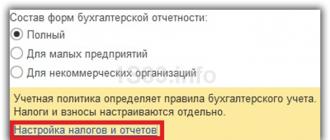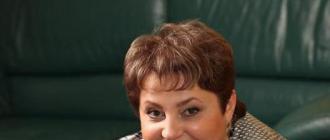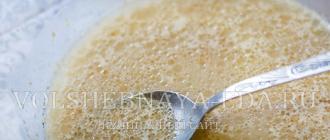Didactic games with cereals. Game set “Krupenichka” and variable forms of working with it.
Klyuka Natalia Aleksandrovna, teacher at MBDOU "Kindergarten" combined type No. 46 "Solnyshko", city center Korolev, Moscow region.
Games with cereals are a fun development for a child!
I offer material on creating the game set "Krupenichka" and possible options children's games with cereals. The material may be useful to kindergarten teachers and parents.
Games with bulk materials perfectly develop sensory perception of the world and fine motor skills of children's hands. It is a known fact that the development fine motor skills hands stimulates the improvement of such body systems as visual, nervous, muscle and bone. This becomes possible thanks to the complex interactions of all these systems when performing small and precise movements, which is the essence of fine motor skills. In addition, any activities on fine motor skills have a beneficial effect on mental development, and therefore on the process of speech cognition, have a calming effect, and develop imagination.
Description of the gaming tool:

Game set “Krupenichka” is a set of 5-8 plastic containers,
filled various types croup:
- semolina
- oatmeal
- buckwheat
- rice
- millet
for older children, the following may additionally be included:
- pearl barley
- corn
- barley, etc.
(plastic spoons and strainers are included with the set)
Purpose:
Designed to familiarize children with various types of cereals, sensory cognition of objects and substances, for the development of fine motor skills and children's creativity.
Description of the developmental properties of the manual:
Promotes the development of fine motor skills, tactile sensations, visual attention and orientation on a plane. Activates imagination and creativity. Develops perseverance.
Age Range: addressed to children 4-7 years old.
Tasks:
1. Introduce children to various types of cereals - semolina, oatmeal, buckwheat, millet, rice, pearl barley, corn, barley;
2. Teach children to distinguish one cereal from another visually and by touch;;
3. Introduce the technology of preparing porridge through a game;
4. Develop children's creative abilities;
5. Activate and enrich children's vocabulary.
- drawing with cereals;
- application from cereals;
- didactic games with cereals;
- role-playing games using cereals.
List of game tasks or exercises with game equipment:
- didactic games and exercises: “Make a pair” (cereals + name of porridge), “Identify by touch” (magic bags of cereals), “Cinderella” (disassemble two cereals - for example, buckwheat rice);
Organoleptic game “Guess the taste of porridge” (this game can be played every day at breakfast, children are asked to eat porridge and guess its name, then find and show a container with a sample of the corresponding cereal).
Role-playing games “Cooks”, “The doll got sick and didn’t eat breakfast”, “Kindergarten”, “Shop”, “I’m on duty”;

- creative tasks “Post a picture” (invite the child to post on a colored A4 sheet, for example, a favorite toy, a winter forest, fantasy flowers, a chicken, a dog, numbers, letters, etc.).

Possible additional uses:
- can be used for individual lessons in mathematics to consolidate orientation on a plane (for example, “Put a sun made of millet in the upper right corner, a buckwheat tree in the lower left, a cloud of oatmeal in the upper left, a semolina house in the lower right, a flower made of any croup);
- you can give creative homework for joint family creativity;
- can be used to develop fine motor skills in children with disabilities.

Games with cereals are a fun activity for children and parents!
Cereals are very useful for developing fine motor skills. Also, digging in the cereal has a calming effect on nervous system child and develops the brain.
Be prepared for the fact that your child may be distrustful of cereals; children are conservative and wary of new things. Do not force your child to touch the cereal; let him watch his mother play with a new object. After a while, curiosity will take over and he will become interested in the game.
This is for babies from one to two years old. You can complement them, come up with something of your own, you can come up with a huge number of games with cereals.
- Remember, if you are distracted from your baby during class, all the cereal will quickly end up on the floor. Tell your child not to spill cereal on the floor.
- It is better to conduct classes sequentially from the first to the second.
- Before moving on to the next lesson, first master the previous one and practice it several times.
- Mastered classes can be combined.
Lesson 1: Introducing the baby to semolina
 Will need:
Will need:
- semolina - 100 grams,
- children's unbreakable plate.
Pour semolina into a plate and show how you can play with semolina, draw something on it and be sure to tell the child what it is. Then take one finger alternately on both hands of the baby and draw different patterns. You can draw the sun, a mushroom, a cloud with rain, a circle, faces and anything you want.
Show the baby how to take mana put it in your fist and sprinkle from top to bottom. Learn how to salt with your fingers. Say the word “as often as possible” semolina“So that the child will remember the name of the cereal over time.
Class 2: Getting to know buckwheat
You will need:
- buckwheat - 2 kg;
- a jar with a lid for vitamins.
Buckwheat perfectly massages a child's hands. Lower your baby's hands into the cereal so that the hands are completely immersed. Squeeze and unclench the buckwheat into your fist, pass it through your fingers, then carefully pull the handles out.
Give your child a jar and let him scoop the cereal into it with his hands and pour it back out. Fill the jar one third with buckwheat and close the lid tightly with the child. Let the baby rattle the jar, and then unscrew the lid with him and pour the buckwheat into the pan.
Don't forget to tell your child often that we are playing. with buckwheat so that he remembers the word.
Lesson 3: Cooking porridge from semolina and buckwheat
You will need:
- buckwheat - 1 - 2 kg;
- semolina - 0.5 kg;
- 5-6 liter saucepan or food-grade plastic box;
- a tray or plastic shallow plate, preferably colored;
- small sieve;
- wooden or plastic spoon.
If you often did the first two lessons with semolina and buckwheat, then the child has already learned to distinguish semolina from buckwheat. We show the cereals to the baby and ask him to determine which is buckwheat and which is semolina. Let the child dig into the cereals, and then pour them into the pan with spoons.
Mix the cereal with a spoon and prepare porridge. You can feed porridge to a bear or dolls from a spoon.
Using a sieve, sift the cereals: the semolina will sift into a plate (tray), and the buckwheat will remain inside the sieve. Let the baby also try to sift the semolina, and then draw on it with his fingers. Repeat the word " sieve“So that the child remembers it.
Place your baby's hands into the buckwheat, squeeze it into your fists and unclench it, pass it through your fingers and pull it out.
Lesson 4: Cereal bags
 You will need:
You will need:
- buckwheat;
- semolina;
- 2 small bags laced at the base so you can tie them tightly.
Let your child spoon semolina into one bag and buckwheat into another. Tie the bags tightly so that your baby cannot untie them.
We ask the child to determine by touch which bag contains buckwheat and which contains semolina. Let the baby roll the bags in his palms - the cereal will massage the hands through the fabric. After a few lessons, the child will be able to easily distinguish cereals from each other by touch.
Lesson 5: Getting to know beans
 You will need:
You will need:
- large beans - about 10 pieces;
- plastic transparent bottle with a volume of 0.5 liters - 1 piece.
Place the beans on a plate in front of the baby and tell them that they are beans. Let the child touch it and get to know it, but be careful not to put it in his mouth.
Take one bean and throw it into the bottle, now let the child take one bean at a time and throw it into the bottle. We invite the child to close the lid and show how the beans rattle in the bottle.
Lesson 6: Magic bags
You will need:
- bags of semolina and buckwheat from lesson 4;
- large beans - 10 pieces;
- a small bag similar to the bags from lesson 4.
We invite the child to pour the beans into the bag, then tie it tightly. Now the baby needs to determine in three bags where the semolina, buckwheat and beans are.
Do not put the bags away after the lesson; let them be in a visible place so that the child can sort through them if desired and develop his tactile sensations.
Did you like it? Tell your friends about this page!
Vera Dedura
Educational games with cereals for children 3 years old
Educational games with cereals for 3 years old. Note for parents. While on vacation or just on the weekend, parents don’t know what to do with their child! Children love to play with water and sand, but for variety you can offer your child games with different grains. It is very interesting and exciting to play! And kids are always passionate about something new.
We will need:
Rag bags (or multi-colored socks in the smallest size);
several plates, lids and boxes (yogurt container, cottage cheese);
1-2 trays;
strainer, spoon;
glue, cardboard, stencil, and of course, a good mood.
Well, now you can start!
1. Bean baths.
Pour beans (peas) into a plate or box, throw small toys in there and stir. And start inventing games, it all depends on your imagination! For example, you can give your child the task of putting his hands in the beans and looking for toys.
If the child is already talking, tell him to identify and name what is hidden in the beans by touch.
The same can be done if you put it in a container with manna grits a few beans. The baby feels them with his fingers and puts them in a bowl. And mom loudly counts the finds until everyone is found.
2. Patterns on the tray.
Sprinkle some small powder on the tray in a thin, even layer. cereal, semolina or flour are more suitable.
If you swipe croup with finger, then you get a contrasting line.
We teach a child to draw. Let him draw a stick, a circle, a square, a sun, a house with a roof, a simple ornament.
On a free tray, show your baby how to sprinkle cereal(this is an exercise develops fine motor skills, calms the child). Using this technique in the future, you can lay out paths and make simple drawings. For "bulk" different types of drawings are taken croup.
3. Magic bags.
Take 10-15 small bags and fill them with peas, beans, rice... you can also use cotton wool, acorns, pine cones, crumpled paper, matches.
You should get 2 bags with the same filling.
Invite your child to find identical bags by touch. Then guess what is poured where.
4. Draw with glue - this game is more difficult.
We will need a sheet of cardboard and a simple stencil, such as a dog or a flower.
Give the child glue, let him spread it inside the stencil, then sprinkle semolina cereal onto the smeared surface, press down.
We remove the stencil and get "painted" drawing. If the child doesn’t like drawing with a stencil, let him move the glue over the piece of paper as he wants. Then cover this sheet with semolina, press down and shake off excess cereal. Look what happened!
Thus the child fine motor skills develop, memory, imagination, perseverance, ability to draw.
I have described a few games, which can be used with cereal, it all depends on your fantasies!
My child really likes to play with cereal, but don’t try to hold your baby for too long! 10-15 minutes will be enough, otherwise cereal will be scattered everywhere, the child will simply get bored!
Publications on the topic:
“Educational games for teaching literacy for older preschool children” Information for parents “Educational games for teaching literacy for older preschoolers” Nadezhda Vyugina Information for parents “Developmental.
According to supporters of the Montessori method, for classes with children it is necessary to use interesting, colorful and unusual materials.
Educational games based on FEMP for children of primary preschool age Didactic game “Once upon a time there were little gnomes in a house” Goal: to form and expand children’s knowledge about numbers from 1 to 5; the ability to correlate.
Games that develop speech for preschool children Working with younger children preschool age, it is necessary to take into account the peculiarities of speech development of children of this age, the steps of speech development.
Consultation “Educational games - the way to the minds and hearts of children” The development and formation of a child’s personality is not possible without play, because a child’s play is his life and childhood companion. The child has many serious matters.
Educational games for children 5–7 years old Educational games for children 5 – 7 years old Games for developing thinking “Guess the picture” Inventory: picture, postcard, paper, scissors. For.
 In every home, every family, stacks of read magazines, newspapers, as well as unnecessary postcards, coloring books, and books are periodically collected.
In every home, every family, stacks of read magazines, newspapers, as well as unnecessary postcards, coloring books, and books are periodically collected.
The more the baby plays with objects that have different textures to the touch (soft, hard, rough, smooth, etc.), the more actively and correctly he speaks.
Cereals (of one type) can be poured into a basin . Add a spoon or a small scoop, various jars, bottles, animal figures that can be hidden in the cereal. You can pour beads into the cereal and then take them back out with your hands and put them in the jar. You can sort them by color.
Games with cereals
Let's pour.Take several plates or other containers. Let the child pour the cereal into the bowls. He can do this either with his fingers or with a spoon. Draw your child's attention to the fact that there is a lot of cereal in one plate, not enough in another, and nothing in the third. Compare quantities: more, less, the same.
Rain. Pour the cereal from one plate to another. In the process, show your little one that he can lift the plate higher and lower. Listen to how she makes noise. Play the game “Rain”: let the child pick up a handful of cereal, raise his hand and pour out the cereal, imitating the way it rains. It is better to take beans or peas for her to make cleaning easier.
Games with cereals will help develop the child’s muscular, visual, nervous and skeletal systems
Paths. From beans, for example, you can make paths - short and long, lay out various designs - geometric shapes, letters, houses, etc.
Filling out the forms. Take any molds (for example, for plasticine or sand), place them on a flat surface and invite your child to fill them inside with cereal. You can pick it up with your hands or a scoop.
Games with tweezers. Give your baby tweezers and encourage him to grab beans with them. This game develops perseverance and, naturally, motor skills.
Well. Take any plastic bottle. Tell your child that this is a well that is completely empty, there is no longer any water in it. And our bear is very thirsty. Help the bear fill the well. Take the cereal and pour it into the narrow neck of the bottle with your hands.
You can also
:
- Spoon the cereal from one bowl to another.
- Try to do this with a fork. Explain to the baby why it didn’t work out.
- Pour the peas into a glass or a plastic bottle (you can take it from a yogurt bottle).
- Pour the cereal into a glass through a funnel.
- Pour the peas into a deep and flat plate.
- Ask to pour cereal into the kitten’s bowl yellow, and the chicken is blue, etc.
- Pour and pour the peas into the container by hand.
A variety of activities in your baby’s daily home life not only introduces him to the world around him, but also allows him to develop some skills. You can even use cereals for classes at home if you know how to organize classes correctly. The games for children with cereals offered on this page develop fine motor skills, thinking, imagination and tactile sensations. Didactic games with cereals, due to their unusual nature, attract the child’s attention and allow him to be captivated for the time the mother needs, for example, to prepare dinner. You can use educational games with cereals from the age when there is no longer any danger that the baby will put cereal grains in his nose or ear.
“Sandbox” or games with semolina for kids
Kids love to play in the sand, and games with semolina are based on the fact that semolina successfully imitates it. A home “sandbox” can be equipped if you use a deep tray and different types of cereals. For example, place a handful of rice on a tray. And then you can change the contents of the sandbox, filling the tray with buckwheat, semolina, or peas. Later, the baby will not only sort out the “sand” for playing with cereals, but also rake it with a spoon, fill yogurt cups with it, pour it from cups into jars, etc.
Semolina pools are one of the most exciting games. How can you play games with cereals for children at home?
- Look for hidden “treasures” in the depths of the “semolina pool” (a deep tray or tray with semolina in which mom can hide small toys or kitchen utensils);
- dig up “rock paintings” - put a sheet of paper with small pictures on the bottom, let the child carefully move the semolina with his fingers and guess who is drawn on the bottom;
- draw “highways” and “roads”, mark roadsides with pasta or beans, carefully guide toy men or animals along the paths;
- set up a “construction site” and “work” with “equipment” - toy bulldozers, trucks, excavators (or their substitutes: spoons, cups, scoops, etc.);
- play archaeologists and dig up all sorts of ancient “bowls” and “dinosaurs” (children’s dishes and small animal toys);
- You can combine several exercises into one. Mix the semolina and rice in one bowl, place another empty one next to it, and show the child how to “catch” the rice with a fine strainer and pour it into the empty bowl. The child will tirelessly watch how the grains of rice remain in the strainer, and the semolina “falls” into the cells. And then the “cleaned” semolina will serve as the basis for drawing;
- Painting on a semolina surface is a pleasure. Pour a thin layer of semolina onto a tray and let the baby draw as much as he wants with his fingers (or the handle of a spoon);
- it is very convenient to show and name geometric shapes - “draw” squares and triangles, circles and ovals;
- “sculpt” Easter cakes using molds.
The question arises: “How can you make a cake from dry semolina? Needed wet sand! In fact, making a sandbox for sculpting Easter cakes is not difficult. Moreover, to do this, you don’t need to carry buckets of sand from the nearest construction site, wash it and bake it in the Oven. There is a much simpler method.
In order to diversify games with cereals for kids, you will need:
- starch - 1 kg;
- water - 2.5 cups;
- food coloring (if you want sand of any color);
- a large plastic tray or pallet for the sandbox itself.
Pour the starch into a tray, add water a little at a time (with dye, if you want) and mix constantly with your hands until you get crumbly wet “sand”. In this process, it is important to add water slowly!
Painting with grains and games to develop fine motor skills
Sorting grains is a children's activity with grains to achieve several goals. First of all, this is a game with cereals for the fine motor skills of a child's hand. Surely you have several types of cereals in your kitchen - rice, buckwheat, semolina, rolled oats, millet, etc. in order to organize children's games with cereals, prepare several plastic containers, pour a handful into each different types separately. And wrap a handful of these cereals in “pounds” - small paper bags. Play "sorter". When playing with cereals, a child needs to distribute the cereals by variety in containers to develop fine motor skills. What's in this bag? Buckwheat? Where is the container with such cereals? Here it is! But first, show how to carefully unwrap the “pounders” so as not to spill the grains (we’re training our fingers!). And then the baby will pour the cereal from the bags into containers. And you need to do this without making mistakes in order to get a wonderful picture. Which?
Cereal drawing is an activity with cereals that allows you to develop the artistic inclinations of a child. When the grains have taken their places in the containers, invite your child to draw a picture. You will need a tray, glue (such as PVA), a brush and an A-4 sheet of paper with a large black and white image drawn (or printed from the Internet). You can draw with a pencil yourself, for example, a house and the sun, or a tree, or a flower, or a fish - something that the child knows. For example, let's say you drew a tree. Ask: what color is the trunk? What cereal is brown? (Buckwheat.) Coat the trunk in the picture with glue and ask the child to carefully sprinkle buckwheat on this place in the picture. Shake the excess grain onto a tray, and the child will see a “real” tree trunk on the sheet! But what about the crown, since there are no green cereals? You can make an “autumn” tree from rolled oats. In exactly the same way, you apply glue, the crumbs sprinkle the cereal, shake off the excess - and here is a tree in front of you! Surely the child will like this type of drawing, and he will want more. Tell them that the tree is autumn, and in the fall it often rains. Therefore, you can draw a cloud and rain. Spread glue randomly over the area of the supposed cloud, and the baby makes a “semolina” cloud. And the rice will be raindrops - you put glue smears in several places, and now it’s raining. Or maybe it's snow? But the sun came out from behind a cloud... By the way, the most wonderful sun with bright rays comes from cheerful yellow millet. So, by drawing and talking, you can “play out” a whole story!
When the baby understands the principle of practicing and drawing with cereals, he will make pictures himself. Your task is to have time to make “sketches”, add glue and teach the baby to hold a brush correctly in his hand.
This article has been read 1,992 times.







